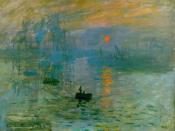Impressionism is one those rare forms of art in history that did not develop through the influence of the Church but rather by the rebellion of a small number of artists against the strict establishment of the time in France. "A 19th century French school of art, Impressionism was more concerned with representing the "impression" some object or scene creates on a viewer rather than what the object "really" is. Thus, a painting of the same object or scene would be done in totally different ways if the atmosphere, lighting, etc. of the situation were to change because such a change would necessarily create a different impression on a viewer." (Cline, Unknown). The Impressionist movement sought to capture the moment in time as quickly and precisely as possible by inventing a new style of painting. The Stroll, completed by Claude Monet in 1875 is but one of the paintings of the time that came to symbolize the era.
In fact, it was Monet's painting "Impression, Sunrise" that first spawned the term Impressionism by an art critic who sought to humiliate these artists who dared to buck the status quo. "The word impressionist was first used mockingly by a journalist to describe a painting by Monet in 1874 entitled Impression: Sunrise. Many artists recognized their style in the word "impressionism" and continued to use the term." (Caro, 1999).
Philosophy of ImpressionismThe art style of Impressionism at first horrified French society but it was soon recognized that the small number of artists who embraced it had envisioned and adapted to new and fresh ideas. Art at this time was mainly controlled by the rigid establishment comprised of the Government and Church. "The Académie was the upholder of traditional standards for French painting, both in content and style. Historical subjects, religious themes,


